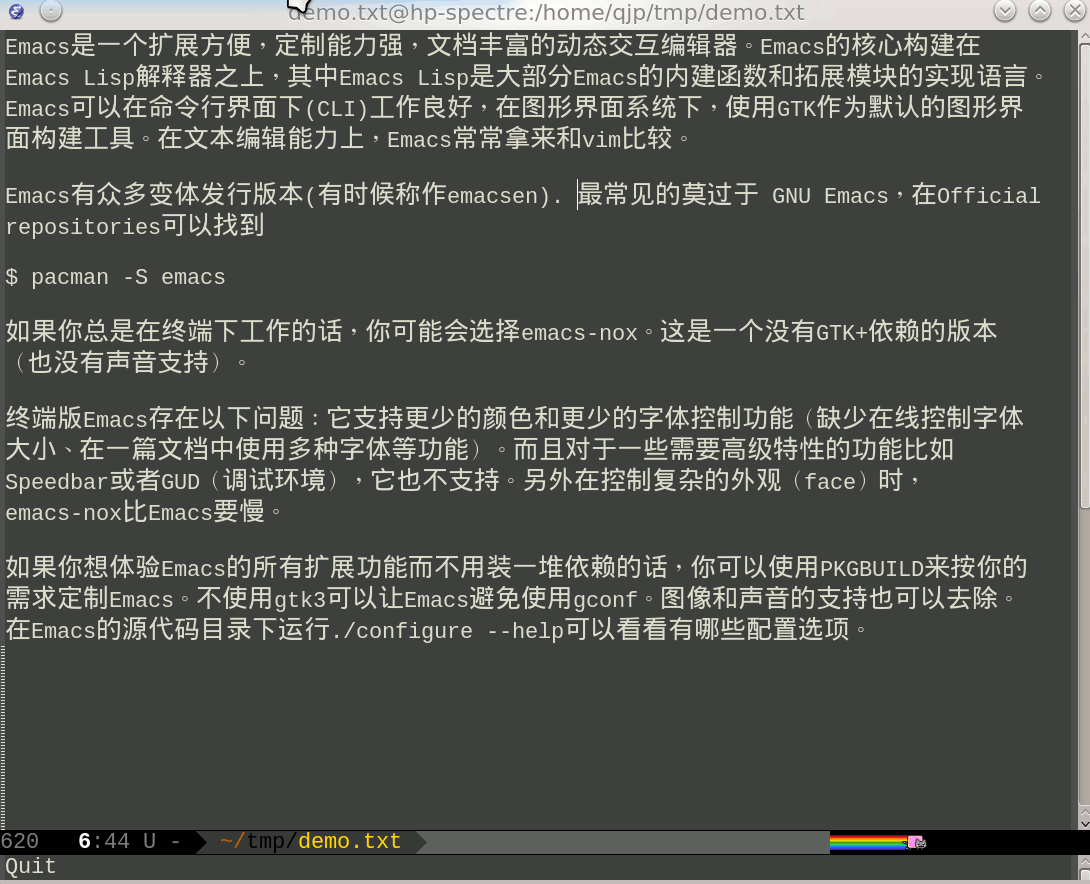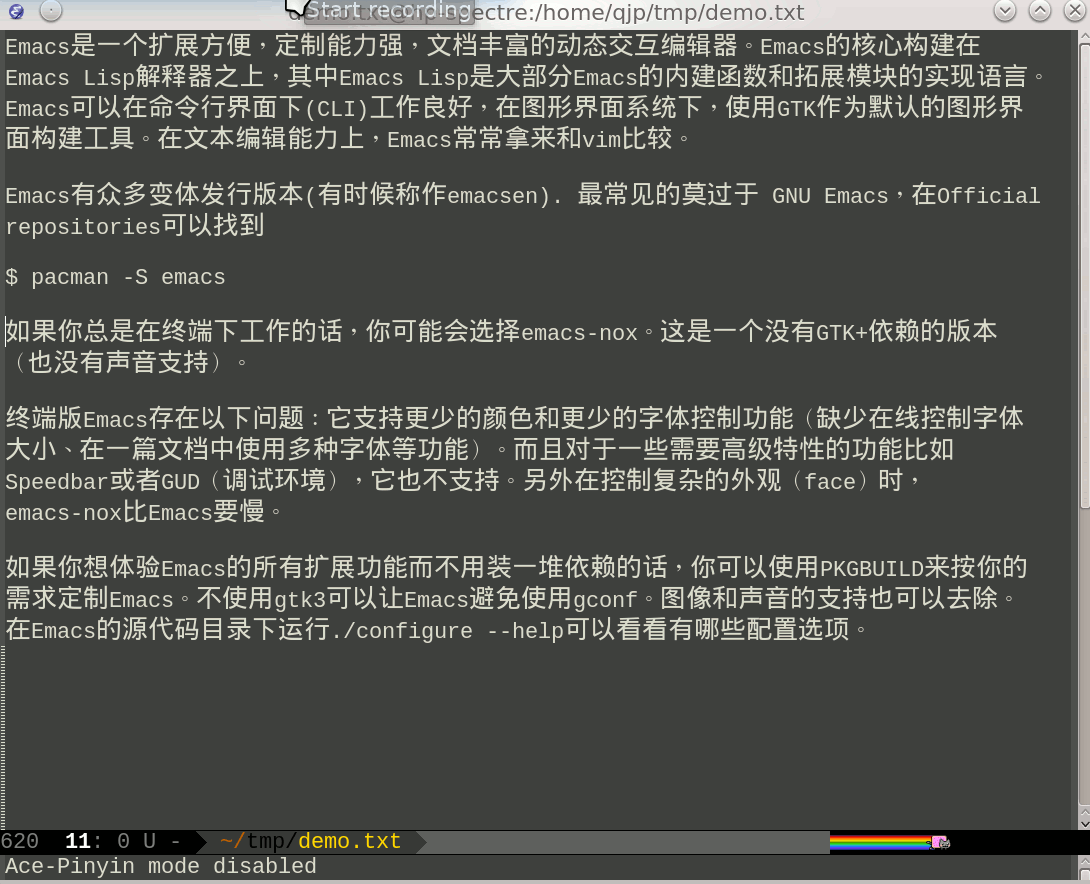Jump to Chinese characters using avy or ace-jump-mode.
使用 avy 或者 ace-jump-mode 跳转到中文字符。
Install via melpa.
Or if you prefer to install this package manually:
(add-to-list 'load-path "/path/to/ace-pinyin.el") (require 'ace-pinyin)
By default this package is using avy. If you want to use ace-jump-mode,
set ace-pinyin-use-avy to nil.
Note ace-pinyin-use-avy variable should be set BEFORE you call
ace-pinyin-global-mode or turn-on-ace-pinyin-mode.
Example config to use ace-pinyin globally:
;; (setq ace-pinyin-use-avy nil) ;; uncomment if you want to use `ace-jump-mode' (ace-pinyin-global-mode +1)
When using avy, all avy commands (as of 05/06/2016) related to char/word
jumping are supported:
avy-goto-charavy-goto-char-2avy-goto-char-in-lineavy-goto-word-0avy-goto-word-1avy-goto-subword-0avy-goto-subword-1avy-goto-word-or-subword-1
When using ace-jump-mode, the following command is supported:
ace-jump-char-mode
When the ace-pinyin-mode is enabled, the supported commands will be able to
jump to both Chinese and English characters/words. That is, you don’t need
remember extra commands or create extra key bindings in order to jump to
Chinese characters. All you need to do is to enable the minor mode and use
your avy or ace-jump-mode key bindings to jump to Chinese characters.
In addition, you can also use English punctuations to jump to Chinese/English
punctuations. For example, use . to jump to both 。 and ., and < to
jump to both 《 and < etc. Behind the scene, ace-pinyin uses
pinyinlib.el to translate the letter to Simplified/Traditional Chinese
characters and English punctuations to Chinese punctuations. To see the full
list of punctuations that are supported, see pinyinlib.el.
Besides, all other packages using ace-jump-mode (or avy) will also be able
to handle Chinese characters. For example, if you’ve installed ace-jump-zap,
it will also be able to zap to a Chinese character by the first letter of
pinyin. Note ace-jump-zap is implemented by using ace-jump-mode, so you
can’t use avy in this case. You can check out my fork of ace-jump-zap
using avy: avy-zap.
By default, ace-pinyin only supports simplified Chinese characters. You can
make ace-pinyin aware of traditional Chinese characters by the following
setting:
(setq ace-pinyin-simplified-chinese-only-p nil)
By default, ace-pinyin will remap both word jumping and character jumping
methods in avy. If you only want to remap character jumping methods, use:
(setq ace-pinyin-treat-word-as-char nil)
After setting this, the following commands in avy are not able to jump to
Chinese characters:
avy-goto-word-0avy-goto-word-1avy-goto-subword-0avy-goto-subword-1avy-goto-word-or-subword-1
If you don’t like the punctuation support(i.e., using English punctuations to jump to both Chinese/English punctuations), use the following code to disable it:
(setq ace-pinyin-enable-punctuation-translation nil)
These commands are not provided in either avy or ace-jump-mode. They’re
provided in this package in case someone finds them useful. You need to assign
key bindings for the commands if you want to use them.
If called with no prefix, it can jump to both Chinese characters and English letters. If called with prefix, it can only jump to Chinese characters.
Using this command, you can jump to the start of a sequence of Chinese characters(i.e. Chinese word) by typing the sequence of the first letters of these character’s pinyins. If called without prefix, this command will read user’s input with a default timeout 1 second(You can customize the timeout value). If called with prefix, then it will read input from the minibuffer and starts search after you press enter.
WARNING: The following demos are a little bit outdated.
Enable ace-pinyin-mode and use ace-jump-char-mode to jump to Chinese
characters:

If you have installed ace-jump-zap, then enabling ace-pinyin-mode will also
make ace-jump-zap-to-char capable of handling Chinese characters.

UPDATE(2015-11-26): Now jumping to traditional Chinese characters is supported
by setting ace-pinyin-simplified-chinese-only-p to nil.
UPDATE(2016-05-01): Now ace-pinyin uses avy by default. If you want to use
ace-jump-mode, use:
(setq ace-pinyin-use-avy nil)
UPDATE(2016-05-02): A new variable ace-pinyin-treat-word-as-char is added and
its default value is t. When this variable is t, ace-pinyin remaps both
word and character jumping commands in avy or ace-jump-mode. For example, if
you’re using avy, setting this variable to t will make avy-goto-word-* and
avy-goto-subword-* be able to jump to Chinese characters as well as English
words.
UPDATE(2015-05-05): Add ace-pinyin-enable-punctuation-translation.
UPDATE(2015-05-05): Now ace-pinyin depends on pinyinlib.el.